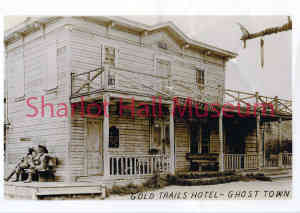Gold Trails Hotel
details
Unknown Unknown 1404-7071-0003.jpg BU-H- 7071 Hand-Tinted Color 1404-7071-0003 buh7071pc Print 8x10 Historic Photographs 1960s Reproduction requires permission. Digital images property of SHM Library & ArchivesDescription
Front view of the Old or Gold Trails Hotel.
This photograph dates to the 1960's. It is thought to be a picture of the hotel as it appeared in the original "Ghost Town" section of Knott's Berry theme park in Buena Park, California. The concrete sculptures of the two figures sitting on the benches are thought to be those by artist Claude K. Bell (1896-1988.) Bell was hired by Knott's owner Walter Knott in 1947 to create these and other renditions. Bell, his wife and daughter, also headed a portrait studio at the Farm from 1951 to 1986 where they worked creating portraits of guests visiting the attaction.
Knott's Berry Farm began in the early 1920's as a roadside berry stand run by Walter Knott and his wife, Cordelia, along State Route 39 in Southern California. In 1940, Mr. Knott began searching for old buildings and facades to create a western motif on his property. Their first building, the Old Trails Hotel, he found, moved and reconstructed from the mostly deserted western stage stop of Bumble Bee, in the former gold country of northern Arizona.
Bumble Bee had once buzzed with activity as it served as a supply and outfitting depot for prospectors, cattlemen and sheepherders in the late 19th and early 20th centuries. It is located about 60 miles north of present-day Phoenix. It was on the original Phoenix-to-Flagstaff thoroughfare, "the Phoenix road," and was heavily trafficked until the present-day Interstate 17 was re-routed and bypassed Bumble Bee beginning in the 1956. In addition, as the amount of gold prospected in the area began to diminish, so did the function and desirablity of Bumble Bee. The property was bought and sold numerous times. New owners tried differing schemes to attract visitors to the area, including adding additional western-style buildings and facades in efforts to attract the motoring public. All enjoyed some initial success but interest waned as other locations and attractions on I-17 grew in number. Currently, most of historic Bumble Bee has vanished and most visitors to the area are RVer's and ATV enthusiasts.
Purchase
To purchase this image please click on the NOTIFY US button and we will contact you with details
The process for online purchase of usage rights to this digital image is under development. To order this image, CLICK HERE to send an email request for details. Refer to the ‘Usage Terms & Conditions’ page for specific information. A signed “Permission for Use” contract must be completed and returned. Written permission from Sharlot Hall Museum is required to publish, display, or reproduce in any form whatsoever, including all types of electronic media including, but not limited to online sources, websites, Facebook Twitter, or eBooks. Digital files of images, text, sound or audio/visual recordings, or moving images remain the property of Sharlot Hall Museum, and may not be copied, modified, redistributed, resold nor deposited with another institution. Sharlot Hall Museum reserves the right to refuse reproduction of any of its materials, and to impose such conditions as it may deem appropriate. For certain scenarios, the price for personal usage of the digital content is minimal; CLICK HERE to download the specific form for personal usage. For additional information, contact the Museum Library & Archives at 928-445-3122 ext. 14 or email: orderdesk@sharlot.org.




